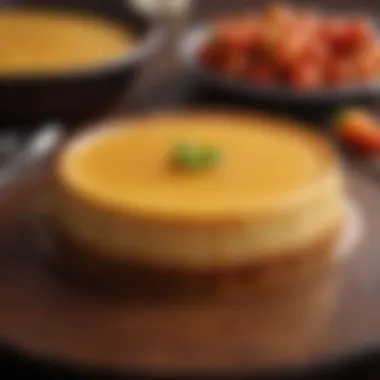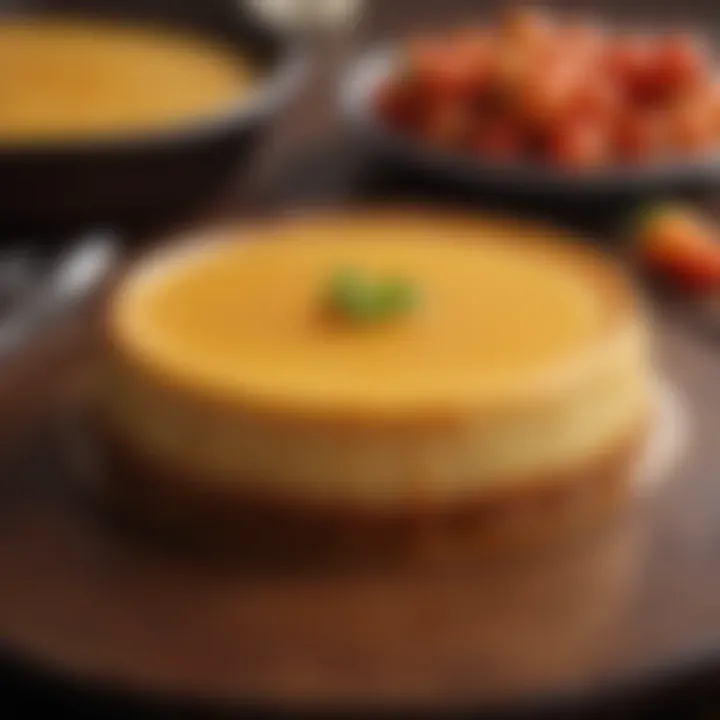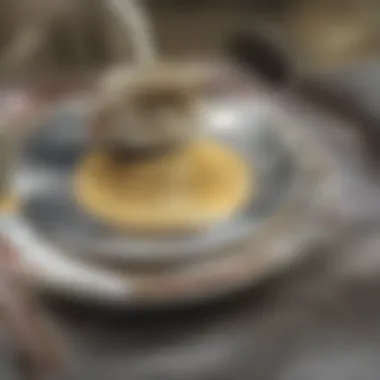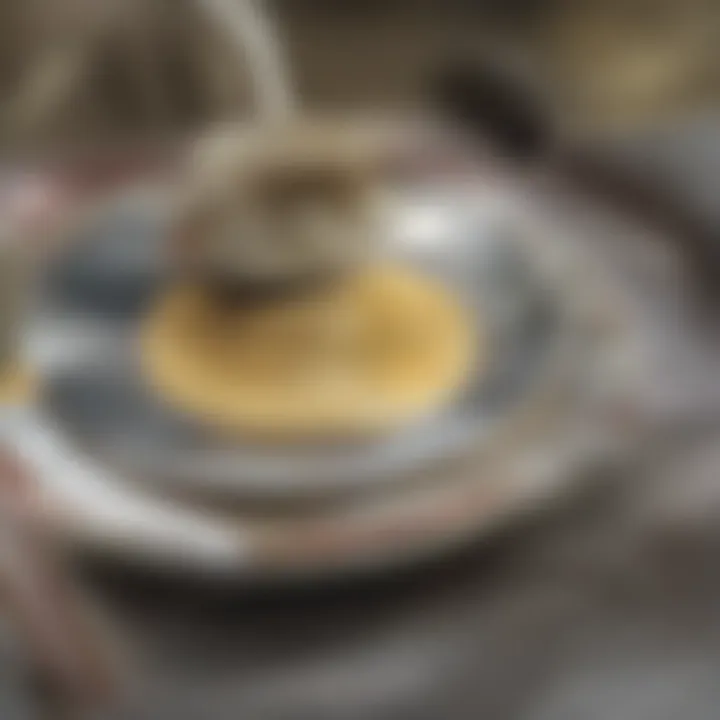Flan Casero: Exploring Tradition and Technique


Intro
Flan casero is a beloved dessert that resonates deeply across multiple cultures. It embodies a rich history and showcases various techniques in its preparation. Rooted in simplicity yet open to interpretation, this custard highlights both regional nuances and personal touches. As we embark on this culinary journey, we will unravel the meticulous crafting of flan casero, focusing on its origins, preparation methods, and the diverse ways it has been embraced within culinary traditions worldwide.
We will address significant components such as the balance of ingredients, the essential role of texture and flavor, and draw comparisons with similar desserts. By the end of this examination, you will gain a thorough understanding of flan casero’s cultural significance and culinary appeal.
Understanding Flan Casero
Understanding flan casero is crucial for anyone looking to appreciate this classic dessert. Flan is not just a sweet treat; it represents a blend of culinary traditions and meticulous techniques that have evolved over centuries. By examining its definition, features, and cultural background, one can grasp why flan holds a special place in various cuisines around the world. This section outlines the essence of flan casero and sets the stage for deeper exploration of its historical roots, preparation methods, and regional variances.
Definition and Key Characteristics
Flan casero typically refers to a traditional Spanish custard dessert with a smooth, creamy texture topped with a layer of caramel. The defining ingredients include milk, sugar, and eggs, which come together to create a rich and velvety custard when baked. The dessert is known for its delicate balance of sweetness and creaminess.
Some key characteristics of flan casero are:
- Texture: A well-prepared flan is creamy and smooth, avoiding any graininess.
- Flavor: The vanilla essence is key, providing a warm note that complements the sweetness.
- Caramel: The layer of caramel on top not only enhances presentation but adds depth to the overall taste.
This dessert is often served chilled and can be sliced into wedges, allowing it to maintain its structure. However, achieving the perfect balance in texture and flavor requires careful consideration of the ingredients and baking methods.
Cultural Significance
Flan casero is more than just a dessert; it is a cultural symbol in many Latin American countries and Spain. Its presence at family gatherings, celebrations, and festivals speaks to its importance in social and culinary traditions. In many homes, flan is prepared for special occasions, serving as a dessert that unites family and friends around the dining table.
The significance of flan extends beyond individual celebrations. Variants of flan can be found in many regions, each adapted to local tastes and ingredients. This adaptability reflects the ability of flan to integrate into different culinary practices, showcasing a shared appreciation for its comforting qualities.
As one explores the rich history and nuances of flan, it becomes evident that this dessert carries a legacy of cultural pride and enduring appeal.
"Flan is not merely a dish; it embodies a heritage passed down through generations, each adding their own touch to this beloved dessert."
Understanding flan casero thus offers insights into the complexities of culinary traditions and invites deeper engagement with the art of dessert-making.
Historical Context of Flan
Understanding the historical context of flan is key to appreciating its role in culinary traditions. This dessert's lineage reveals much about the cultural exchanges and social evolutions that shaped its numerous variants. By exploring its origins and developments across different societies, we can uncover how flan casero serves as a lens through which to view broader historical narratives.
Origins in Medieval Europe
The essence of flan can be traced back to medieval Europe. It originated as a savory dish, primarily made with eggs and cream. The use of these basic ingredients was not exclusive to dessert; many cultures incorporated them into main dishes. It was during this time that flans began to shift from savory to sweet. The introduction of sugar from the Middle East via trade routes dramatically shifted this dessert's perception. Initially, flans were a luxury item, enjoyed mostly by the upper class, highlighting a society that thrived on culinary experimentation and innovation.
The marriage of sugar and cream redefined culinary practices. Flan gained popularity in recipes that utilized local dairy products and seasonal flavors. In this period, regional variations began to take shape, influenced by local tastes and available resources. This sweet custard, though simple, held a complexity that provided insight into the social classes enjoying it.
Evolution Across Cultures
The evolution of flan extends well beyond Europe. As we examine different cultures, we can identify unique adaptations of this custard. The Spanish influence, in particular, marked a significant transition in flan's history. Spanish flan, also known as flan de huevo, gained prominence in the 16th century. Its rise correlates with the Spanish colonization of Latin America, which introduced flan to new audiences.
In Mexico, for instance, flan transformed into a beloved national dessert. The traditional recipe evolved to include unique local ingredients such as vanilla and sometimes caramel. Meanwhile, in the Philippines, the dessert further diverged into leche flan, characterized by the addition of condensed milk and a denser texture. This adaptation was also influenced by the country’s Spanish colonial history.
Various migrations and trade interactions have emptied flan into a polycultural dessert. Today, it remains an iconic culinary representative in multiple countries, symbolizing a shared heritage that celebrates its multifaceted nature. As it continues to adapt and evolve, flan serves as an edible timeline reflecting historical events, personal stories, and collective memories.
"Flan is not just a dessert; it's a narrative rich with history, influence, and cultural exchange."
Through this lens, we see that flan is much more than a sweet treat. It embodies the complexities of history, migration, and culinary evolution.
Ingredients of Flan Casero
The ingredients used in Flan Casero are fundamental to crafting this traditional dessert. Each component plays a distinct role, shaping the flavor and texture while bringing cultural significance to the dish. Understanding these ingredients aids in appreciating Flan Casero's complexity and diversity, allowing for personal adaptations and enhancements.
Base Ingredients
Milk
Milk is the primary base for Flan Casero, lending the custard its creamy and smooth texture. The choice of milk can affect the overall consistency and richness of the flan. Whole milk is often favored for its fatty content, which helps create a velvety mouthfeel. The key benefit of using milk is its ability to blend seamlessly with the other ingredients, providing coherence and depth to the flavor profile. One downside to consider is that the type of milk used can alter the final product's sweetness, as varying fat content can influence how sweet the flan tastes.
Eggs
Eggs are essential for binding the ingredients together and contributing to the structure of the flan. The proteins in eggs coagulate when heated, forming a delicate and custardy consistency that characterizes a well-prepared flan. Their high nutritional value also adds to the appeal, making flan a more substantial dessert. However, overcooking can lead to a rubbery texture, which detracts from the dish's quality. Thus, careful temperature control during cooking is crucial.
Sugar
Sugar provides sweetness and plays a role in caramelization. It enhances the overall flavor, balancing the richness of the milk and eggs. Different types of sugar can be used, such as granulated sugar or brown sugar, each imparting a unique taste. The primary characteristic of sugar is its ability to dissolve and integrate into the mixture, ensuring even sweetness. However, excessive sugar can risk overshadowing the other flavors, making control over its use vital in the recipe.
Vanilla
Vanilla is the final touch in this simple yet rich dessert. It elevates the flavor profile, imparting warmth and depth. While vanilla extract is commonly used, some may prefer vanilla beans for a more intense and fragrant experience. Its unique feature lies in how it complements the sweetness from the sugar, creating a harmonious balance. Nonetheless, overemphasizing vanilla can lead to overwhelming the dish's natural sweetness.
Optional Ingredients and Additives


Coconut Milk
Coconut milk is an alternative that can provide a tropical flair to Flan Casero. Its rich and creamy texture enhances the overall mouthfeel. The key characteristic of coconut milk is its distinct flavor, which can create a unique version of flan that stands apart from traditional recipes. However, using coconut milk can also mask the flavors of other ingredients, requiring careful balance to avoid overpowering the dish.
Cream Cheese
Cream cheese can be added to flan to introduce a richer, tangier flavor profile. It serves as a stabilizing agent, contributing to the smoothness of the custard. The advantage of cream cheese is its ability to bind the ingredients while providing a unique twist on classical recipes. However, it may alter traditional taste perceptions, so familiarizing oneself with its role is important when preparing Flan Casero.
Liquor Variations
Liquor can also be incorporated into Flan Casero for an adult twist. Common choices include rum or brandy, adding complexity to the flavor. The key advantage is that it enhances the richness while contributing additional aromatics. However, care must be taken to avoid overpowering the delicate flavors of the base ingredients, as too much liquor can overwhelm the dessert's subtlety.
Remember: Each ingredient plays its role in crafting Flan Casero, creating a symphony of flavors and textures that reflect its rich cultural heritage.
Preparation Techniques
Preparation techniques are crucial when it comes to flan casero, as they directly impact the custard's texture, flavor, and overall presentation. Each method requires attention to detail and an understanding of how various elements interact during the cooking process. Mastering these techniques can elevate a simple recipe into a sublime dessert, showcasing the art of culinary precision.
Basic Cooking Methods
Baking
Baking is one of the primary methods used to prepare flan casero. This technique allows the custard to develop a gentle, even heat that is essential for proper cooking. When baking, the flan is usually placed in a water bath, which helps to regulate the temperature, preventing the edges from cooking too fast. This slow, steady heat leads to a smooth and creamy texture, which is a key characteristic of a well-made flan.
The benefits of baking include:
- Consistent Texture: Baking in a water bath creates a uniform environment, reducing the risk of overcooking or curdling.
- Flavor Development: This method allows the flavors to meld and deepen, providing a more complex taste.
However, one disadvantage is that it can be time-consuming as flan typically requires a longer cooking period in the oven.
Water Bath Techniques
Water bath techniques are often used in conjunction with baking for flan casero. By placing the flan into a larger pan filled with hot water, the custard is insulated from direct heat. This technique ensures that the dish cooks evenly and slowly, giving the proteins in the eggs time to coagulate without curdling.
Water baths are particularly beneficial because they provide precise temperature control, which is critical for achieving the desired velvety texture.
Key characteristics of water bath techniques include:
- Gentle Cooking: This method prevents hot spots, which can lead to a grainy texture.
- Moisture Retention: The water surrounding the dish helps to keep the custard from drying out.
One potential drawback is the risk of water leaking into the flan dish if not properly sealed, potentially compromising flavor and texture.
Achieving Optimal Texture
The texture of flan casero is a defining feature that determines its quality and appeal. To achieve the perfect mousse-like consistency, several factors must be taken into account. These include both the choice of ingredients and the precision of cooking methods. The correct ratio of milk and eggs is vital, as well as the use of fresh ingredients for the best flavor.
Key tips for achieving optimal texture include:
- Tempering the Eggs: Gradually introducing warm milk to the eggs can prevent curdling, ensuring a smooth mixture.
- Mixing Techniques: Avoiding excessive whisking is important to prevent incorporating too much air, which can create bubbles in the final product.
Caramelization Process
The caramelization process is essential in the creation of flan casero. This step contributes not only to the dessert's signature flavor but also to its visual appeal. The transformation of sugar to caramel generates complex flavors that enhance the overall experience of flan. The balance between the subtle sweetness of the flan and the rich, toasty notes of caramel achieves a harmonious arrangement that is both delightful and indulgent.
Understanding Caramel Formation
Caramel formation begins with the heating of sugar. When sugar is heated, it undergoes a series of chemical reactions. First, it melts into a syrup and begins to change color and flavor as it continues to cook. This Maillard reaction creates a range of flavors, from nutty to somewhat bitter. Several factors can influence this transformation, including temperature and time. Ideally, sugar should be cooked slowly and carefully monitored to prevent burning. A high temperature can lead to a bitter taste and undesirable texture. Instead, aiming for a medium heat allows for gradual development of those rich flavors while avoiding overcooking.
Some key considerations for effective caramel formation are:
- Type of Sugar: Granulated white sugar is the most common, as it caramelizes uniformly. Other sugars, like brown sugar, can add different flavors but may require slightly adjusted cooking times.
- Moisture Content: The presence of water can facilitate an even melt, preventing private burning. However, too much moisture can interfere with the final texture of the caramel.
- Temperature Control: Keeping the temperature consistent is crucial. The sugar should reach a golden amber color before it is removed from the heat to achieve the right flavor without crossing the threshold of bitterness.
Incorporating Caramel into Flan
Incorporating caramel into flan is a straightforward yet vital process. Once the caramel reaches the desired color, it must be carefully poured into the mold. This creates a syrupy layer at the bottom that will later become the topping when the flan is inverted after cooking. The key to effective incorporation lies in ensuring that the caramel is evenly distributed to create a consistent flavor throughout the dessert.
When creating flan casero, follow these steps for incorporating caramel:
- Prepare the Caramel: Heat sugar in a saucepan over medium heat. Stir occasionally until the sugar starts to melt. As it turns into a syrup, watch closely for the golden color.
- Coat the Mold: Once the caramel is ready, quickly pour it into a round mold. Swirl it gently to coat the base evenly before it hardens.
- Add Flan Mixture: After the caramel has set, carefully pour the flan mixture over the hardened caramel. This helps ensure that the flavors meld perfectly during the baking process.
- Baking: Bake the flan as per the desired method, allowing the caramel to further infuse into the custard while maintaining its consistency.
Utilizing these strategies ensures that caramelization not only adds visual allure but also contributes the essential flavor profile that defines flan casero. By mastering this process, you can elevate any flan recipe to a new level.
Variations of Flan Casero
Exploring variations of flan casero reveals the adaptability and global appeal of this beloved dessert. Each regional variant brings distinct flavors, textures, and cultural significance that enrich our understanding of flan. This section will focus on how these variations embody local ingredients and culinary practices, highlighting their unique characteristics and contributions to the broader narrative of flan casero.
Regional Variants


Mexican Flan
Mexican flan stands out with its rich, creamy texture and slightly more pronounced sweetness compared to other versions. A key characteristic is its use of sweetened condensed milk, which contributes to the custard's smoothness and density. This flan is especially popular at family gatherings and celebrations, becoming a staple at many festive occasions.
The unique feature of Mexican flan is the addition of cinnamon, giving it a subtle warmth that enhances its overall flavor profile. The advantages of this variant include its widespread acceptance and the comfort it provides to those familiar with it from childhood memories. However, the sweetness can be overwhelming for those not accustomed to desserts that lean heavily on sugary notes.
Spanish Flan
Spanish flan, often referred to as "flan de huevo," is characterized by its simplicity and classic preparation techniques. It generally has fewer ingredients than its Mexican counterpart; the emphasis is on eggs and milk, resulting in a firmer base. What sets Spanish flan apart is its smooth, silky texture and balanced sweetness, appealing to a broader range of palates.
The appeal of Spanish flan lies in its versatility. It can be served in various cultural contexts, making it a suitable choice for both everyday enjoyment and special events. However, the simplicity might be viewed as a disadvantage by those seeking more vibrant flavors or textures.
Philippine Leche Flan
Philippine leche flan is distinguished by its use of egg yolks, resulting in a richer custard. This variant is notably denser and more indulgent, often enhanced with evaporated milk and topped with a luscious caramel layer that adds depth. Leche flan is a favorite at major celebrations, where it symbolizes prosperity and good fortune.
Its unique feature is the pronounced caramel flavor, which contrasts beautifully with the rich custard. The advantages of leche flan include its visual appeal and luxurious taste, commonly created for significant gatherings. However, its richness may make it less appealing for those seeking lighter dessert options.
Modern Interpretations
Flan with Fruit Toppings
Flan with fruit toppings represents a contemporary twist on traditional recipes. This adaptation includes fresh fruits like berries or tropical fruits like mango, which add a refreshing acidity to balance the custard's sweetness. The crowning feature is the vibrant color and texture that fruits offer, making the flan visually appealing.
One major advantage of this variation is the health aspect; incorporating fruits can enhance the nutritional value. However, the natural sugars from the fruits could lead to an overly sweet dessert for some individuals, demanding an understanding of flavors while preparing.
Vegan Flan Options
Vegan flan options have emerged in response to the growing demand for plant-based desserts. By using coconut milk or almond milk and plant-based ingredients like agar-agar or silken tofu, these versions still capture the essence of traditional flan while eliminating animal products. The key characteristic is their ability to mimic the creamy texture of traditional flan, catering to a wider audience.
The advantage of vegan flan is its inclusivity, allowing those with dietary restrictions to enjoy a classic dessert. However, some may find that these alternatives lack the depth of flavor found in traditional recipes, challenging the perception of what flan can be.
Flan casero showcases a distinct culinary legacy, demonstrating how traditional recipes can adapt to various cultural influences and modern trends.
Pairing Flan Casero
Pairing flan casero successfully is an essential aspect of savoring this classic dessert. The right pairings enhance its flavors and elevate the overall dining experience. Considering how complementary items align with the notes of flan casero enriches the appreciation for this dish. More than a simple dessert, flan can take center stage when paired well with beverages and dishes that balance its richness and sweetness.
Beverage Pairings
Coffee
Coffee serves as a thoughtful companion to flan casero. The bitterness of coffee contrasts beautifully with the sweetness of the flan, creating a harmonious balance. Many coffee enthusiasts appreciate the deep, warm notes of a well-brewed cup. An ideal choice could be a medium roast, which provides a smooth foundation that does not overpower the delicate flavors of the flan. The caffeine kick can also complement the dessert's creamy texture. However, care should be taken with overly strong or bitter coffee as it might overshadow the subtlety of flan. To maintain a pleasant experience, it is best to opt for lighter brewing methods.
Dessert Wines
Dessert wines, such as late harvest varietals or even a sweet Moscato, can enhance the enjoyment of flan casero. These wines are crafted to be sweet, making them a natural fit alongside a milky dessert. The key characteristic of dessert wines is their ability to amplify sweetness without becoming cloying. Rich but not overpowering, these wines maintain an ideal profile that can elevate the sweet notes of the flan. One should be cautious, however, as too much sweetness might overwhelm the palate. It is best to select wines with a balanced acidity to prevent this.
Complementary Dishes
Pastries
Pastries bring a delightful texture contrast to flan casero. Their flaky, buttery nature introduces a new element, creating an engaging combination with the smoothness of the custard. Many desserts can include pastries, such as tarts or croissants, that resonate with the audience's preference for rich textures. The variety found in pastries allows for creative pairings, but it is advisable to choose those with lighter fillings so as not to divert attention from the flan. The visual appeal also plays a role, enhancing the overall presentation of the dessert table.
Cheese Plates
Cheese plates provide another intriguing pairing option for flan casero. The creaminess and saltiness of cheeses complement the sweetness of the flan while offering a diverse tasting experience. Including cheeses such as Brie or Goat cheese can create a rich contrast with the dessert. These cheeses add depth without overwhelming the flavorful nuances of the flan. Furthermore, including accompaniments such as dried fruits and nuts on the cheese plate can introduce pleasant flavor interactions, enhancing the overall enjoyment. Care must be taken, though, to avoid aged cheeses that may clash with flan's unique richness.
Storing and Serving Flan
Storing and serving flan is crucial to maintain its delicate texture and rich flavor. This section focuses on best practices to ensure that flan remains as fresh and appealing as possible. Proper storage can extend its shelf life, while thoughtful serving enhances the eating experience. By knowing how to handle this custard properly, one can appreciate its qualities even more.
Best Practices for Storage
When it comes to storing flan, there are several important elements to consider:
- Refrigeration: Flan should always be kept in the refrigerator. The cool temperature helps to preserve its creamy texture and prevents bacterial growth. Flan can be stored in its baking dish or removed and placed in an airtight container.
- Covering: It's essential to cover flan with plastic wrap or a lid if stored in a container. This prevents it from absorbing odors from other foods in the fridge. Moreover, it helps maintain the moisture level in the flan.
- Shelf Life: Properly stored flan typically lasts about three to five days in the refrigerator. However, it is best enjoyed within the first couple of days after preparation for optimal taste and texture.
- Freezing: While freezing flan is not recommended due to potential texture changes, some may choose to freeze it. If doing so, it's critical to place the flan in a suitable container, ensuring it is well wrapped. Thaw it slowly in the fridge before serving, but expect a slight alteration in creaminess.
Serving Suggestions
Presenting flan is an art in itself. Here are some effective ideas for serving:
- Chilling: Serve flan cold. This enhances its refreshing quality and provides a satisfying contrast to its rich flavor.
- Garnishes: Adding a dusting of cinnamon or a drizzle of caramel sauce can elevate the presentation. Fresh fruit like berries or slices of mango can also add color and vibrancy, appealing visually to guests.
- Portioning: Slice flan into uniform pieces for uniformity. This helps guests to enjoy a fair share without the mess.
"Presentation can change the perception of a dish; a well-served flan invites curiosity and anticipation."
- Accompaniments: Consider pairing flan with a dollop of whipped cream or a scoop of vanilla ice cream. These additions can create interesting contrasts in flavor and texture.


In summary, understanding the best storage practices can prolong the life of flan while enhancing the serving experience can significantly impact its enjoyment. With deliberate care in both aspects, flan can continue to be a delightful dessert, admired for both its taste and its beautiful presentation.
Common Mistakes in Flan Preparation
Understanding the common pitfalls in flan preparation is vital for achieving the perfect texture and taste. Many aspiring cooks overlook certain details which can lead to less than ideal results. Recognizing these mistakes can lead to a more successful cooking process, allowing for a delightful dessert that honors tradition and technique.
Overcooking and Its Consequences
One of the most frequent errors in flan preparation is overcooking. This can happen easily, especially when using an oven or water bath that is not properly calibrated. Overcooked flan may become rubbery, losing the desired creamy texture that is characteristic of well-made flan. It can also develop an undesirable eggy flavor which detracts from the sweetness.
To avoid overcooking, one must pay attention to the cooking time and the temperature. It’s essential to use a reliable thermometer to monitor the internal temperature. Ideally, the flan should be removed from the heat when it reaches about 180°F. This ensures that the custard will continue to set as it cools without becoming overdone.
Key Tips to Avoid Overcooking:
- Monitor the cooking time closely, especially during the final stages.
- Use a water bath to maintain a gentle and even heat.
- Always check the internal temperature before removal from the oven.
Inadequate Caramelization
Inadequate caramelization is another common mistake that can significantly affect the flavor and visual appeal of flan. Caramel not only serves as a sweet sauce but also affects the overall balance of flavors in the dessert. Poorly made caramel can result in a syrup that is either too bitter or lacks the depth of flavor that complements the custard.
To achieve proper caramelization, one must select the right sugar and take the time to melt it correctly. Keeping the heat at a moderate level is crucial. Too high of a heat can cause the sugar to burn, while too low may not fully dissolve the sugar. Stirring the sugar too frequently can also lead to crystallization, which can ruin the smooth texture.
Steps to Ensure Proper Caramelization:
- Choose a suitable sugar, like granulated white sugar, for the best results.
- Allow the sugar to melt without stirring; gently swirl the pan occasionally.
- Monitor closely until it reaches a rich amber color, then promptly remove from heat before it darkens too much.
In summary, avoiding overcooking and ensuring correct caramelization are crucial steps in preparing flan casero. Attention to these details can elevate the dish, making it a cherished part of culinary tradition.
Health Considerations
Understanding the health aspects of Flan Casero is essential, particularly for those who are mindful of their dietary choices. This dessert, while delicious and rich in flavor, contains several ingredients that contribute to its nutritional profile. Thus, it is crucial to balance enjoyment with health considerations to cater to a wider audience.
Nutritional Profile of Flan Casero
Flan Casero typically consists of milk, eggs, sugar, and vanilla. Each ingredient plays a role in its nutritional content:
- Milk: Provides essential calcium, protein, and vitamins A and D. The type of milk used can affect the calorie count; whole milk has a higher fat content than skimmed.
- Eggs: Add high-quality proteins and essential amino acids. They also contribute to the texture, offering creaminess that is characteristic of flan.
- Sugar: While it adds sweetness, excessive sugar intake is a concern for health. It contributes to caloric intake without nutritional benefits.
- Vanilla: Although used in small quantities, it can enhance flavor without significant caloric contribution, offering a pleasant taste.
A single serving of traditional flan can contain around 300-400 calories, primarily from sugar and fat. Understanding these numbers can guide individuals in moderation.
Modifications for Healthier Versions
To make Flan Casero more health-conscious, several adjustments can be explored. After all, modifications allow for enjoyment without guilt. Here are some practical suggestions:
- Lower Fat Milk: Using skim or almond milk can reduce calories and fat while maintaining a creamy texture.
- Natural Sweeteners: Replacing granulated sugar with healthier alternatives, like honey or stevia, can minimize the calorie count and provide different flavor profiles.
- Egg Substitutes: For those looking to cut cholesterol, egg replacements like flax seeds or chia seeds can be used, though this may alter the final texture.
- Adding Nutrient-Rich Ingredients: Incorporating pureed fruits, like mango or avocado, can enhance flavor while adding vitamins and healthy fats.
- Portion Control: Serving smaller portions can help manage calorie intake while still allowing indulgence.
These modifications can maintain the essence of Flan Casero while making it suitable for a health-conscious audience. Incorporating these insights can encourage more people to enjoy this traditional dessert without compromising their health goals.
"Health considerations are essential to enjoying traditional dishes like Flan Casero while being mindful of dietary impacts and caloric content."
Cultural Celebrations Featuring Flan
Flan holds a significant position in cultural celebrations across many communities. Its presence is not merely that of a dessert; it symbolizes tradition, heritage, and family gatherings. The act of sharing flan at events amplifies its importance. As a custard dish, flan embodies the spirit of togetherness. Each region has distinct customs and rituals that highlight flan, making it more than just a sweet treat.
Flan in Festivals and Traditions
Flan often appears during festivals, marking important dates and events within various cultures. For instance, in Mexico, flan is a staple during celebrations such as birthdays, weddings, and religious festivities. The creamy texture and rich flavor make it a fitting choice for special moments. It reflects the joy of these occasions, allowing families to connect through shared recipes passed down through generations.
Moreover, in Spain, flan is cherished during national holidays. It is commonly served after traditional meals, becoming almost a ritual itself. The preparation and presentation of flan during such events create an atmosphere of celebration and nostalgia. Its simplicity belies its ability to enhance the festive spirit.
The sight of flan at these gatherings often evokes memories and conversations. It encourages people to recount personal stories related to the dessert, reinforcing familial bonds and cultural identity.
Flan as a Gift in Various Cultures
Gifting flan is another expression of appreciation and affection in numerous cultures. In many Latin American countries, presenting a flan as a gift during celebrations is customary. It signifies care and thoughtfulness. Homemade flan becomes a symbol of personal effort, showcasing one's culinary skills. This is particularly relevant during holidays or gatherings with friends.
In some settings, flan may also be offered to neighbors or as a token during visits. This tradition signifies hospitality and generosity, as sharing food creates connections between people. Additionally, during festive seasons, flan is often exchanged among families and friends, highlighting its role in fostering community spirit.
In summary, flan is more than just a dessert; it connects people through shared experiences and cultural heritage. Its role in festivals and as a gift strengthens bonds, making it a cherished element of communal celebrations. As a focal point in such traditions, flan carries stories and emotions, adding significance to its already essential place in culinary culture.
End
The conclusion serves as a pivotal point in this article, bringing together all the threads woven throughout the exploration of flan casero. It is essential to reflect on how each aspect discussed contributes to a deeper understanding of this dessert. Flan's enduring popularity across cultures underscores its significant role not just as a dessert, but as a custodian of heritage and tradition.
Reflecting on Flan's Timeless Appeal
Flan casero captivates with its simplicity and elegance. The balance of creamy texture and sweet caramel creates a canvas for culinary creativity. This dessert shows how fundamental ingredients can come together to form something much greater than their individual parts.
In addition to being delightful, flan brings people together. It is often present at family gatherings, celebrations, and festivals, making it more than just food but part of shared experiences. Whether served on special occasions or enjoyed as an everyday treat, flan offers comfort and nostalgia.
"Flan is not merely a dish. It evokes memories and cultural identity, binding generations through taste and tradition."
As the culinary landscape continues to evolve, flan casero remains resilient. Its capacity to adapt while retaining its basic form demonstrates its versatility. Variations like Mexican flan or vegan options showcase how cultures reinterpret traditional recipes to fit contemporary tastes.
Ultimately, the story of flan is a reminder of the lasting nature of culinary traditions. Understanding flan casero is not just about tasting a dessert; it's about appreciating a rich tapestry of history, culture, and shared moments. This dessert, in all its variations, will likely continue to evolve while retaining its timeless charm.







